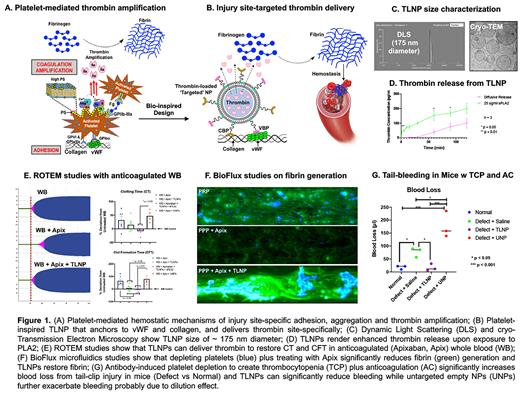Abstract
Non-compressible uncontrolled hemorrhage remains a major cause of mortality from traumatic injuries. Additionally, patients with congenital, disease-associated or drug-induced hemostatic dysfunctions, may often be at risk of excessive bleeding. Therefore, treatments that render rapid hemostasis are clinically significant in potentially saving lives. The clinical gold standard for this is the transfusion of whole blood (WB) or blood components (e.g. controlled ratios of platelets, RBCs, and plasma), as evidenced by several clinical studies (e.g. PROPPR, PROMMTT and PAMPer). However, the availability of such blood products is donor-dependent, their shelf-life is limited due to contamination risks, and, their portability and storage is often challenging. While extensive research efforts are currently being focused on addressing these challenges, e.g. using low titer Group O whole blood, cold-storage and freeze-drying of platelets and plasma, in vitro generation of platelets from iPSCs etc., a parallel research focus has emerged in designing biomaterials-based I.V.-administrable technologies (nanoparticles, polymers etc.) that can provide specific functional attributes of hemostasis while allowing donor-independent manufacturing, scale-up, and on-demand availability. Prominent examples of these are 'synthetic platelet' (SynthoPlate) nanoparticles that recapitulate platelet's binding interactions with von Willebrand Factor (vWF), collagen and active platelet integrin GPIIb-IIIa, flexible platelet-like particles (PLP) that bind fibrin to recapitulate platelet's biomechanical properties, fibrinogen function-mimicking nanoparticles that amplify the aggregation of active platelets, peptide-modified synthetic polymers (e.g. PolySTAT, HAPPI etc.) that render clot stabilization etc. In this framework, we present the design and evaluation of I.V.-administrable unique platelet-inspired nanoparticles that render injury site-targeted, enzyme-responsive direct delivery of thrombin, to site-specifically augment fibrin generation for hemostasis. Our design is inspired by platelets' crucial hemostatic mechanisms of : (i) rapidly accumulating at the injury site to form a plug and (ii) serving as a coagulation amplifier via presenting anionic phospholipids on the activated platelet surface to render tenase and prothrombinase factor assemblies leading to thrombin (FIIa) burst, which can then site-specifically convert fibrinogen to fibrin. Thrombin delivery to augment hemostasis is clinically well-accepted, as exemplified by products like Tisseel where thrombin and fibrinogen are co-delivered by syringe directly at wound site. Researchers have also studied thrombin-loaded topical dressings and topical administration of thrombin-loaded particles on wounds to mitigate bleeding, but these cannot be used intravenously. A recent interesting study has explored encapsulation of thrombin-loaded nanoparticles inside actual platelets with the idea of the particles being released (analogous to granule secretion) upon platelet activation, but this was only demonstrated in vitro because optimizing this complex strategy for consistent in vivo function may be challenging. Our approach circumvents these challenges by: (i) loading consistent amount of thrombin in I.V.-administrable lipid nanoparticles (LNPs), (ii) directly targeting the thrombin-loaded LNPs (TLNPs) to the injury site via specific binding to vWF and collagen, and (iii) releasing the loaded thrombin via particle destabilization by the action of injury site-specific enzyme phospholipase A2 for in situ fibrin production. We evaluated the TLNPs in vitro in human blood and plasma where hemostatic defects were created by platelet depletion and anticoagulant treatment. Spectrophotometric studies of fibrin generation, rotational thromboelastometry (ROTEM) based studies of clot characteristics and BioFlux microfluidics based real-time imaging of fibrin generation under simulated vascular flow conditions, confirmed the ability of TLNPs to restore fibrin generation in hemostatic dysfunction settings. Subsequently, the in vivo feasibility of these TLNPs was tested in a mouse tail-clip bleeding model where a combination of platelet depletion plus anticoagulant treatment was used to render significant hemostatic defect. TLNPs were able to effectively reduce tail-bleeding in mice.
Sen Gupta: Haima Therapeutics: Other: Co-founder, Patents & Royalties: US 9107845, US 9107963.


This feature is available to Subscribers Only
Sign In or Create an Account Close Modal